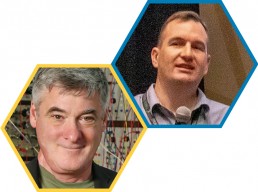About
AI & Robotics
AI & Robotics at the Science Hub is a team of MIT and Amazon researchers working together at the intersection of autonomous mobile robots, optimization, control, and perception. Relevant challenges in AI & robotics include simultaneous localization and mapping (SLAM) and applying recent deep learning advances to applications in robotics. The intersectional approach of the AI & Robotics team results in technology that brings state-of-the-art robotics to homes around the world.
Simulating how robots can carefully handle objects at high-speeds in cluttered space
Autonomous systems that can manipulate objects at high speeds are still scarce and limited. This project will investigate autonomous systems that can move around highly diverse objects in densely occupied spaces at high speed. A main challenge is to enable robots to work and interact with different types of objects that can be rigid, articulated (e.g. books), separable (e.g. boxes), and deformable (e.g. bags), so as to not damage them. For scalability, the robotic system should be flexible -- able to improve continuously with experience and generalize to previously unseen objects, materials, shapes and motions.
This work is a collaboration between MIT faculty Phillip Isola, Alberto Rodriguez and Russ Tedrake, and Amazon researchers Andrew Marchese and Lesley Yu.


Building the brains behind the robots that fill your Amazon order
Every time you place an Amazon order, a fleet of robots is hard at work packaging your items. With up to a thousand moving robots in a given warehouse and dozens of robots working together to fill just your order, efficient coordination is a must. This project aims to optimize the algorithms behind the robots' behaviors and movements to seamlessly sort inventory and fill orders in a timely manner, all while avoiding collisions and ensuring on-time fulfillment of customer orders.
This work is a collaboration between MIT faculty Cynthia Barnhart, Alex Jacquillat, Cathy Wu, and Amazon researchers Michael Wolf and Lesley Yu
Safety and Predictability in Robot Navigation for Last-mile Delivery
Economically viable last-mile autonomous delivery requires robots that are both safe and resilient in the face of previously unseen environments. With these goals in mind, this project aims to develop algorithms to enhance the safety, availability, and predictability of mobile robots used for last-mile delivery systems. One goal of the work is to extend our state-of-the-art navigation algorithms (based on reinforcement learning (RL) and model-predictive control (MPC)) to incorporate uncertainties induced by the real world (e.g., imperfect perception, heterogeneous pedestrians), which will enable the learning of cost-to-go models that more accurately predict the time it might take the robot to reach its goal in a real world scenario. A second goal of the work is to provide formal safety guarantees for AI-based navigation algorithms in dynamic environments, which will involve extending our recent neural network verification algorithms that compute reachable sets for static obstacle avoidance.
This work is a collaboration between MIT faculty Jonathan How and Amazon researcher Tye Brady.


Multimodal tactile sensing
We propose to build the best tactile sensor in existence. We already can build robot fingers with extremely high spatial acuity (GelSight), but these fingers lack two important aspects of touch: temperature and vibration. We will incorporate thermal sensing with an array of liquid crystal dots covering the tactile display; the camera will infer the distribution of temperature from the colors. For vibrations, we will try various sensing methods, including IMU’s, microphones, and mouse cameras.
This work is a collaboration between MIT faculty Edward Adelson and Amazon researcher Curt Salisbury.
Soft artificial intelligent tactile sensing arrays for interactive surfaces and human-robot interaction
Multimodal sensory information can help robots to interact more safely, effectively, and collaboratively with humans. Artificial epidermis with very compact electronics integration that can be wrapped onto any arbitrary surface, will need to be realized. Herewith, we propose a bio-inspired, high-density sensor array made on a soft deformable substrate for large-scale artificial intelligent sensor. This enables our proposed research effort to scale and fabricate a dense artificial sensor and apply various self-organizing networking and novel sensing techniques for large-scale interaction, localization, and visualization with applications in robotics, human-machine interfaces, indoor/environmental sensing, and cross-reality.
This work is a collaboration between MIT faculty Joseph Paradiso and Amazon researcher Curt Salisbury.


Manipulation of Rigid Point Cloud Objects
Our project is aimed at integrating affordance perception models with sequential planning, with the goal to progress toward autonomous robotic systems capable of manipulating novel objects in unstructured settings. We plan to extend a recently developed framework to plan sequences of actions to manipulate rigid body point clouds, while leveraging state-of the art point-cloud encoders such as Graph Attention Networks (GAT) or Neural Fields. We plan to apply this framework to: 1) Learn affordance models for composite manipulation actions (sequences of simple interaction primitive), such as first toppling an object to then grasp it and finally placing it at a different location; and 2) Interactive perception and manipulation of rigid body point clouds with several objects.
This work is a collaboration between MIT faculty Alberto Rodriguez and Amazon researcher Neel Doshi.
Robotic Systems with Force Interactions: An Automated Design Pipeline
Traditional robotic system design methods require extensive, time-consuming, and manual trial and error to produce a viable design. We propose an integrated design pipeline to streamline the design and manufacturing of robotic systems for tasks that include force interactions. We propose to develop a novel manipulator shape space which allows us to express diverse manipulator shapes with various topologies and sizes. The end result is an intuitive design paradigm that allows the creation of new designs of manipulators. Funded by Amazon Robotics.
This work is a collaboration between MIT faculty Wojciech Matusik and Amazon researchers Andrew Kimmel and Yuri Ivanov.

